drawing for understanding
I have been making quick sketches lately of objects that belong to children, as part of my research into how student teachers develop a deep understanding of the child. I sometimes feel that words don’t cut it alone. A list of words of what is in a child’s school bag is a wonderful thing. But a list of words and images of those objects is more, somehow.
My thinking on the purpose and nature of these drawings took me back to Sawdust and Threads ( 2015). This is a small publication by artist Caroline Wright, in collaboration with the Norfolk Museum Service, that emerged out of an exhibition and project on museum objects that were in the process of ‘rationalisation’, when a museum removes an object from its care. Wright explored a range of such objects - from a reel of florist’s wire to a baby’s bonnet - by meticulously drawing them and then carefully physically deconstructing them and disposing of them. The book shares Wright’s thoughts on the process: on the nature of museum collections; how the value of objects is defined; and the journey that objects take, from beginning to end.
“With an object in my hand, I have become part of the history attached to its being.”
“Graphite impressions form a musical score. In which order to place the semi-quavers, crochets and minims? I am a conductor, re-explaining the object.”
How do these ideas relate to student teachers/teachers building an understanding of the children they work with, the objects within the classroom, children’s belongings, the objects that help us begin to understand something of children, childhood and the individual within that?
And, wider than that, how can we support teachers and student teachers to view and use objects (and perhaps drawing, if they choose) in this thoughtful and valued fashion? Should the use of drawing, as an approach to learn and understand more, have a place within teacher training? And if yes, where might it fit in?

